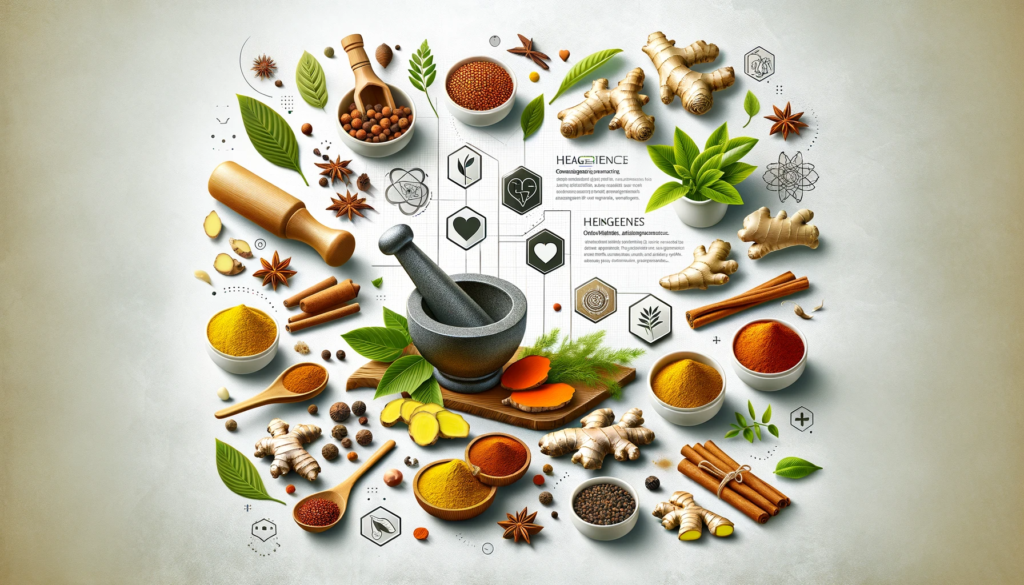Low-Sodium Cooking with African Spices: Flavorful Heart-Healthy Recipes
Welcome to the world of vibrant flavors and healthful eating, where we explore the culinary wonders of African spices merged with the principles of low-sodium cooking. Our journey will unveil how you can enjoy the rich tapestry of African tastes while also taking care of your heart and overall well-being. Prepare to indulge in a collection of recipes that promise to delight your palate without the added salt!
Introduction to Low-Sodium Cooking with African Flavors
The Benefits of Reducing Sodium in Your Diet
Embarking on a low-sodium diet can be a transformative experience for both your taste buds and your health. High sodium intake is often associated with increased blood pressure and a heightened risk of heart disease. By cutting back on salt, you can help manage your blood pressure, reduce the strain on your heart, and improve overall cardiovascular health. Now, let’s unveil how African spices come into play to revolutionize your low-sodium cooking.

African Spices as Natural Flavor Enhancers
Overview of Sodium-Free African Spices
African spices boast an array of complex, bold flavors that can transform any dish into an exquisite creation without reliance on salt. From the fiery heat of peri-peri to the aromatic warmth of cumin, each spice offers depth and intensity. The continent’s spice palette is naturally sodium-free, allowing you to unleash savory notes and subtle aromas in your cooking without the health implications of sodium.
How Spices Can Replace Salt in Cooking
Introducing spices into your cooking is an art that opens doors to possibilities where sodium is no longer the protagonist. Spices carry the dual ability to elevate the natural flavors of your ingredients while imparting their unique character to the dish. Mastering their use is key to developing complex, layered flavors that allow salt to take a backseat, proving that healthy cooking doesn’t equate to bland eating.
Heart-Healthy Recipes Using African Spices
Berbere-Spiced Vegetable Stew
Dive into the heart of Ethiopian cuisine with this hearty Berbere-spiced vegetable stew. Berbere, a blend of chili peppers and aromatic spices, infuses the stew with a bold, piquant flavor profile, eliminating the need for salt. As the vegetables simmer, they absorb the intense flavors, culminating in a comforting dish that nourishes the body and soul. This stew is a testament to how spices can become the cornerstone of low-sodium, high-flavor cooking.
Harissa-Flavored Grilled Chicken
Invoke the spirit of North Africa with this zesty Harissa-flavored grilled chicken. Harissa, a Tunisian hot chili pepper paste, is mingled with garlic, herbs, and spices to create a marinade that transforms ordinary chicken into an extraordinary feast. With its robust, fiery taste, Harissa adds a kick that makes additional salt unnecessary. Grilling the marinated chicken imparts a smoky flavor and seals in the juicy succulence, complemented by the spice-infused crust.
Ras el Hanout Couscous Salad
Ras el Hanout, the “top of the shop” spice blend, rich with over a dozen spices, is the star of this refreshing couscous salad. Perfect for a health-conscious yet flavorful meal, this salad combines fluffy couscous grains with a rainbow of vegetables, all dressed in a Ras el Hanout vinaigrette. Each bite offers a tapestry of flavors, including hints of coriander, allspice, and cardamom, that meld beautifully together, obviating the need for added salt.
Suya-Spiced Tofu Skewers
Experience the streets of West Africa with these Suya-spiced tofu skewers. The magic of Suya lies in its mix of peanuts and spices, which creates a rich and nutty crust when grilled. As tofu is known for its ability to soak up flavors, marinating it in this potent mixture guarantees that each skewer is bursting with taste. Fire up the grill for a low-sodium and plant-based delight that breaks all the misconceptions of health food being flavorless.
Cardamom-Infused Fruit Salad
Indulge your sweet tooth with this exquisite cardamom-infused fruit salad. Aromatic cardamom pairs perfectly with the natural sweetness of fruit, enhancing the flavors without additional sugar or salt. This fragrant spice elevates the freshness of ripe fruits and imparts a citrusy and floral note, making each spoonful a refreshing treat. It proves once again that the joys of dessert can be thoroughly enjoyed within a heart-healthy diet.

Tips for Creating Flavorful Low-Sodium Dishes
Techniques for Maximizing Flavor Without Salt
Crafting a low-sodium dish that is rich in flavor requires ingenuity and a good understanding of ingredients. Techniques such as toasting spices to release their essential oils, incorporating acid like citrus juice or vinegar for brightness, and using umami-rich ingredients like mushrooms and tomatoes can all elevate a dish’s taste profile. Layering flavors by adding fresh herbs, garlic, or onion also brings complexity to recipes, ensuring that your meals are flavorful and satisfying while maintaining a heart-healthy focus.
Balancing Spices and Herbs in Cooking
When cooking with spices and herbs, balance is key. Understanding how different flavors work together is vital, as well as knowing when to use a light hand or when to boldly season. Aromatic herbs like parsley, cilantro, and dill can complement earthier spices like cumin and turmeric. Furthermore, infusing oils with herbs and spices before adding them to your dish can subtly enhance the overall flavor without overshadowing the main ingredients, harmonizing your low-sodium culinary creations.
The Health Benefits of African Spices
Nutritional Advantages of Incorporating Spices
African spices are not only champions of flavor but also possess noteworthy health benefits. Many of these spices contain anti-inflammatory and antioxidant properties, which can aid in the prevention of chronic diseases and boost overall health. For instance, turmeric’s curcumin is renowned for its medicinal qualities, and cinnamon is celebrated for its blood sugar-regulating abilities. Incorporating a diverse range of spices into your diet equates to a sensory delight and an array of nutritional gains.
The Role of Spices in a Balanced, Heart-Healthy Diet
In a low-sodium, heart-healthy diet, spices serve an essential role by reducing reliance on salt without sacrificing flavor. They promote a diet that’s full of taste and variety, which is key to sustainable healthy eating. Spices like garlic powder, cayenne, and ginger can enhance heart health by improving cholesterol levels and circulation. Similarly, the capsaicin in peppers is linked to metabolic benefits. Integrating these spices supports a heart-healthy diet rich in flavor and therapeutic qualities.

Adapting Traditional African Recipes to Low-Sodium Versions
Modifications for Popular African Dishes
Transforming beloved African dishes into low-sodium alternatives does not have to mean compromising on their authentic taste. It’s all about swapping high-sodium ingredients with spice-rich alternatives to maintain their characteristic zest. For example, using vinegar and spices instead of soy sauce in marinades or choosing herbs instead of bouillon cubes for broths. By making these simple tweaks, traditional recipes can be reimagined to fit a health-conscious lifestyle while staying true to their roots.
Substituting Spices for Salt in Classic Recipes
A fundamental shift in seasoning techniques is integral to successfully reducing salt in classic recipes. Spices like smoked paprika can provide the savoriness that might be missed when salt is reduced, while a squeeze of lemon juice can bring a fresh and bright contrast. By deeply understanding the flavor profiles of African spices, one can expertly substitute and even enhance the original flavors of time-honored dishes, thus preserving their essence and providing a healthier twist.
FAQs on Low-Sodium African Cooking
What are some easy switches to reduce sodium in my favorite African dishes?
To reduce sodium, use spices and fresh herbs like basil, thyme, or mint to enhance natural flavors. Swap out canned ingredients for fresh or dried alternatives, and utilize salt-free stocks and broths. Citrus juices and vinegars are great for adding zesty notes that salt typically would.
How can I effectively use African spices without making dishes too hot?
Start by using mild spices like cinnamon or cumin and gradually add hot spices like cayenne or chili flakes to your preferred taste level. Mixing hot spices with cooling ones like mint or coriander can also balance the heat in your dishes.
Can I still achieve umami flavor in low-sodium cooking?
Absolutely. Umami-rich ingredients like mushrooms, ripe tomatoes, olives, and fermented foods such as kimchi or unsalted miso can add that savory depth of flavor typically attributed to sodium-heavy ingredients.
Are there particular African spices that also have health benefits?
Yes, many African spices offer health benefits. Turmeric has anti-inflammatory properties, ginger aids in digestion, cinnamon can regulate blood sugar levels, and cardamom may lower blood pressure. Integrating these into your diet can contribute to overall well-being.
What is the best way to store African spices to preserve their flavor?
Keep spices in a cool, dark place away from heat sources. Airtight containers are crucial to prevent spices from losing their potency. It’s also important to avoid shaking spices directly over cooking pots to keep them free from moisture.
How do I modify recipes that call for packaged spice blends which contain salt?
Create your own spice blends using salt-free, individual spices. You can often replicate the flavor of a packaged blend by combining the primary spices and adjusting to taste. This puts you in control of the flavor and sodium content.
What tips do you have for someone new to cooking with African spices?
Become familiar with the spices by taste-testing them individually. Start with common blends like Berbere or Ras el Hanout in small amounts, and learn about the cultural context of these spices for a deeper understanding of how to integrate them into your dishes appropriately.
